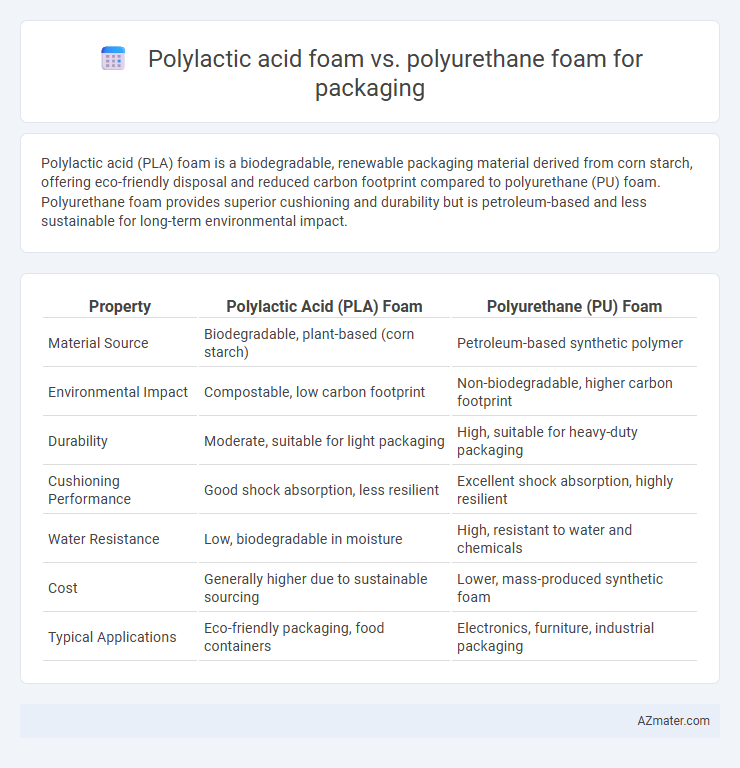Polylactic acid (PLA) foam is a biodegradable, renewable packaging material derived from corn starch, offering eco-friendly disposal and reduced carbon footprint compared to polyurethane (PU) foam. Polyurethane foam provides superior cushioning and durability but is petroleum-based and less sustainable for long-term environmental impact.
Table of Comparison
| Property | Polylactic Acid (PLA) Foam | Polyurethane (PU) Foam |
|---|---|---|
| Material Source | Biodegradable, plant-based (corn starch) | Petroleum-based synthetic polymer |
| Environmental Impact | Compostable, low carbon footprint | Non-biodegradable, higher carbon footprint |
| Durability | Moderate, suitable for light packaging | High, suitable for heavy-duty packaging |
| Cushioning Performance | Good shock absorption, less resilient | Excellent shock absorption, highly resilient |
| Water Resistance | Low, biodegradable in moisture | High, resistant to water and chemicals |
| Cost | Generally higher due to sustainable sourcing | Lower, mass-produced synthetic foam |
| Typical Applications | Eco-friendly packaging, food containers | Electronics, furniture, industrial packaging |
Introduction to Polylactic Acid and Polyurethane Foams
Polylactic acid (PLA) foam is a biodegradable, renewable material derived from fermented plant starch, offering eco-friendly packaging solutions with compostable properties. Polyurethane (PU) foam is a versatile synthetic polymer known for its high durability, cushioning, and resistance to impact, widely used in protective packaging. Both foams differ significantly in environmental impact, mechanical properties, and application suitability across various packaging needs.
Chemical Composition and Structure Comparison
Polylactic acid (PLA) foam, derived from renewable resources like corn starch, consists primarily of polylactic acid polymers with a semi-crystalline structure, offering biodegradability and lower environmental impact compared to petroleum-based polyurethane (PU) foam. Polyurethane foam is composed of urethane linkages formed by the reaction of polyols and isocyanates, resulting in a highly versatile, durable, and flexible polymer network with open or closed-cell structures depending on formulation. The chemical composition of PLA foam provides rigidity and compostability, while PU foam's complex cross-linked structure offers superior cushioning and resistance to wear, making each suited for different packaging applications based on performance and eco-friendliness.
Manufacturing Processes Overview
Polylactic acid (PLA) foam is produced through fermentation of renewable resources like corn starch, followed by polymerization and a foaming process involving heat and gas expansion, emphasizing eco-friendly and biodegradable manufacturing. Polyurethane foam manufacturing relies on chemical reactions between polyols and isocyanates, with additives controlling density and rigidity, allowing for versatile customization in packaging applications. Both processes differ in raw material origin and environmental impact, with PLA foam offering sustainable alternatives and polyurethane foam providing tailored performance characteristics.
Mechanical Properties and Performance
Polylactic acid (PLA) foam offers lower density and biodegradability, making it an eco-friendly packaging alternative, but it exhibits lower tensile strength and impact resistance compared to polyurethane (PU) foam. PU foam provides superior mechanical properties including high compressive strength, excellent elasticity, and enhanced cushioning performance, which ensures better protection for delicate items during shipping. Despite PLA foam's sustainability advantage, PU foam remains the preferred choice in packaging applications demanding durability and repeated impact absorption.
Thermal Insulation Capabilities
Polylactic acid (PLA) foam provides moderate thermal insulation with a typical thermal conductivity ranging from 0.034 to 0.045 W/m*K, making it a sustainable choice for packaging requiring biodegradable materials. Polyurethane (PU) foam exhibits superior thermal insulation performance, with thermal conductivity values as low as 0.020 W/m*K, offering better energy efficiency and protection against temperature fluctuations. Despite PLA foam's environmental benefits, polyurethane foam remains preferred for packaging applications demanding high-performance thermal insulation.
Environmental Impact and Biodegradability
Polylactic acid (PLA) foam offers significant environmental benefits over polyurethane foam due to its origin from renewable resources like corn starch and its compostable properties, enabling faster biodegradability under industrial composting conditions. Polyurethane foam, derived primarily from petrochemicals, is non-biodegradable and contributes to long-term landfill waste, posing challenges for environmental sustainability. The reduced carbon footprint and enhanced end-of-life biodegradation of PLA foam make it a preferred choice for eco-friendly packaging applications.
Cost Analysis and Market Availability
Polylactic acid (PLA) foam generally incurs higher production costs compared to polyurethane foam due to bio-based raw material expenses and less mature manufacturing processes. Polyurethane foam benefits from extensive market availability and established supply chains, resulting in lower prices and widespread adoption in packaging industries. The growing demand for sustainable alternatives is gradually improving PLA foam's cost competitiveness, but polyurethane remains dominant in terms of affordability and accessibility.
Packaging Applications: Use Cases
Polylactic acid (PLA) foam is widely used in packaging applications requiring compostability and environmental sustainability, such as food containers, protective packaging for electronics, and disposable trays. Polyurethane (PU) foam excels in protective packaging for fragile items, including automotive parts, appliances, and heavy-duty industrial equipment, due to its superior cushioning and durability. PLA foam offers advantages in short-term use and biodegradability, whereas PU foam is preferred for long-term protection and resistance to compression.
Safety and Regulatory Considerations
Polylactic acid (PLA) foam offers a biodegradable alternative to polyurethane foam, significantly reducing environmental impact while meeting stringent safety standards such as FDA food contact regulations and ASTM D6866 for biobased content. Polyurethane foam, though highly durable and flexible, often contains isocyanates and other chemicals that can pose inhalation risks during manufacturing and disposal, necessitating strict Occupational Safety and Health Administration (OSHA) guidelines. Regulatory compliance for PLA foam is increasingly favorable due to its renewable sourcing and compostability, supporting sustainable packaging mandates under frameworks like the EU's Packaging and Packaging Waste Directive.
Future Trends in Sustainable Packaging Foams
Polylactic acid (PLA) foam, derived from renewable resources like corn starch, offers a biodegradable alternative to traditional petroleum-based polyurethane foam, aligning with increasing consumer demand for eco-friendly packaging. Future trends indicate a rapid growth in the adoption of PLA foam due to its compostability and lower carbon footprint, driven by stricter environmental regulations and corporate sustainability goals. Innovations in PLA foam formulations focus on enhancing durability and thermal insulation properties, narrowing the performance gap with polyurethane foam while maintaining a significantly reduced environmental impact.

Infographic: Polylactic acid foam vs Polyurethane foam for Packaging
 azmater.com
azmater.com